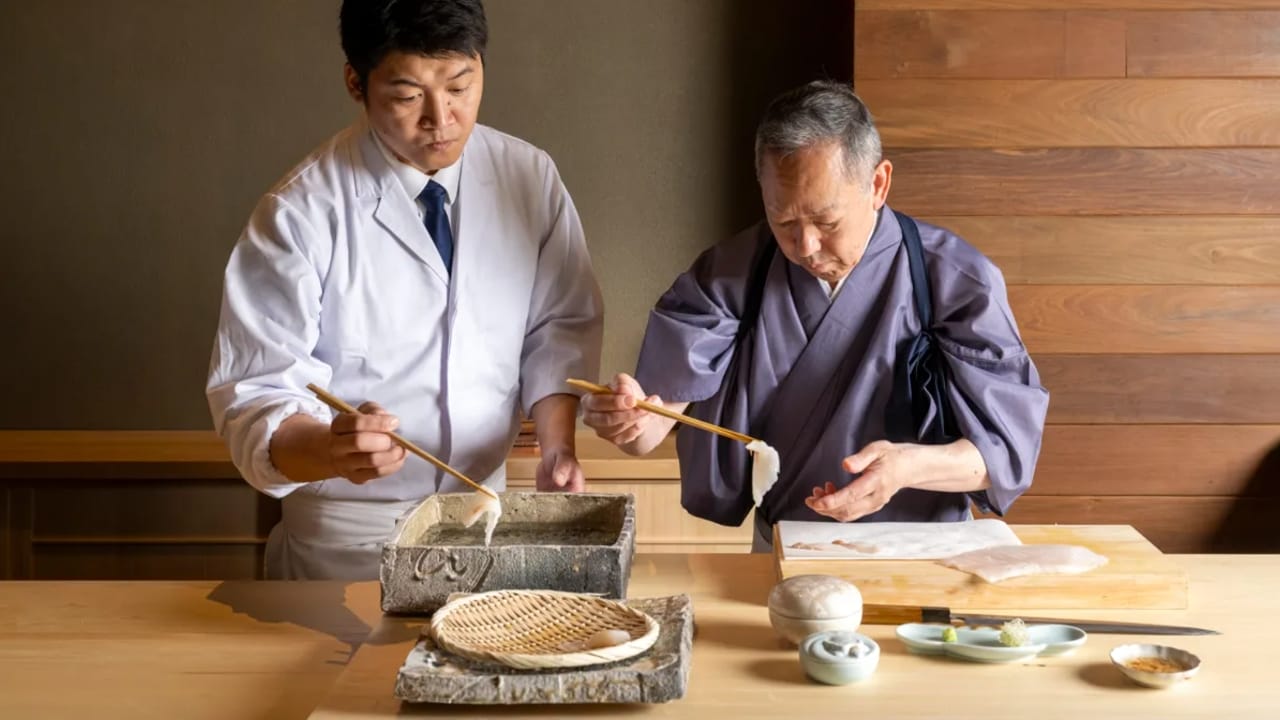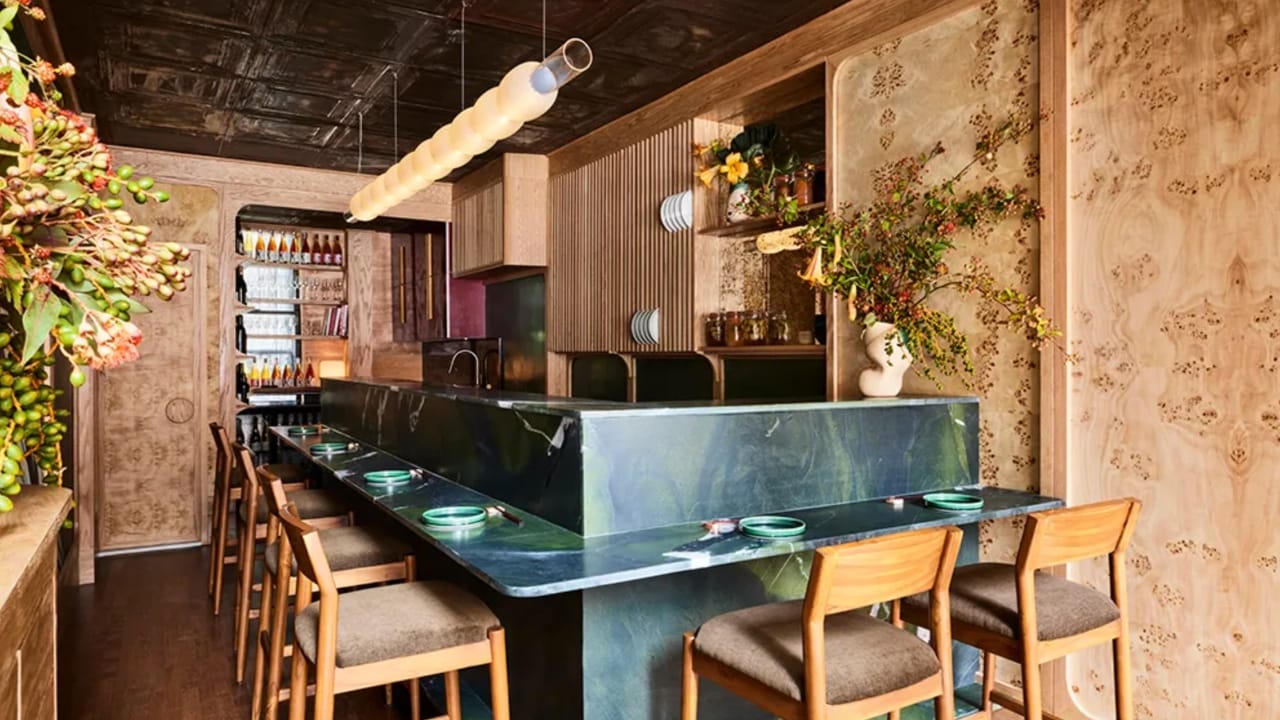Eiji Ichimura’s wooden sandals clip-clopped against the floor as he entered his namesake, 10-seat sushi bar in Tribeca. The 71-year-old itamae chatted with diners and sliced fish as Manabu Asanuma, the chef who creates the restaurant’s kaiseki courses, sent out a flurry of dishes: a pleasantly chewy clam with white asparagus and silken chawanmushi; uni and caviar sandwiched between a crunchy mochi rice cracker; and two translucent slivers of red snapper lying on wasabi leaf and dotted with ume. Soon enough, Ichimura began to form the traditional, Edomae-style nigiri for which he’s known, his hands moving as if in a trance as he shaped rice, dabbed wasabi onto fish, and pressed together perfect, minimalist bites.
Ichimura emigrated from Tokyo to New York in the 1980s for a job at Takesushi, one of two serious sushiya in the city at the time, he says. Most sushi restaurants focused on modern, cross-cultural rolls, and he recalls having to add sugar to his rice to cater to American palates. “It was a different world back then!” recalls Ichimura.
Indeed, it was. New York City now has at least 140 omakase spots, as tracked by Sushi Legend, an anonymous sushi obsessive, who chronicles New York City’s omakase scene. Los Angeles boasts more than 80, and Miami, Austin, Dallas, and Houston are adding new counters at a dizzying clip. Fuelling it all is a certain type of diner, one who can wax on the nuances of steamed and seasoned Inochi-no Ichi rice and appraise knife work as if it were vintage Patek Philippe. These diners’ connoisseurship reflects omakase’s decade-plus ascent in America, but it comes at a price—both literal and figurative.
“It’s great that people have an appreciation for the craft, and it raises the collective bar that people know and mostly understand terms like Edomae, shari and, yes, even, omakase. But when more people are aware of something, a funny thing happens,” Sushi Legend wrote me via email. “A great sushiya becomes a status symbol rather than an experience. That attracts pretentiousness and eventually prices out most of the newly aware. It’s a loop that I’m not smart enough to find a name for.”
In many ways, omakase has become the gravitational centre of big-spending, power dining. One of the core tenets of power dining, of course, is control, which omakase has in spades. It’s almost entirely predictable: the pace, number of courses, ingredients, rituals. The fish and shellfish vary seasonally but not so much that they’re a shock to the system. Omakase is a cocoon of knowing, and for the ultra-wealthy, in particular, it has become a virtual personality, an aesthetic choice, a stealth wealth display, or less charitably, a “bit of dick measuring contest,” says Max Shapiro, a Beverly Hills-born real estate agent, whose been enjoying “pampering dining experiences” since he was a teen.

Back in 2012, when the country fell for the romance of Jiro Dreams of Sushi, American omakase prices tapped out at $150. A mere 90 percentre could afford a meal. Now, there’s no shortage of counters that serve $500 dinners—a 233 percent increase. Masa charges $950.
Robby Cook, who ran Morimoto’s sushi counter for years and now serves his own $275 omakase at Coral, suspects that high-end sushi will continue to grow more expensive.
“I used to go out to all the new places, but now it’s like, do I really want to drop $1,000 bucks on a meal with the same fish I’m getting?” he muses.
Shapiro likens regulars of these four-figure meals to fine wine collectors; the communities overlap. “To understand sushi, you have to have eaten it so many times. It’s like you don’t know good Champagne, unless you’ve consumed a lot of different bottles,” says Shapiro. “It’s so nuanced that the layman is not going to be able to tell the difference between anything.”
With so few reservations available, and so few people who can afford them anyway, certain omakase restaurants have essentially become private clubs. The first year it opened, Shapiro dined at Brandon Hayato’s Hayato four to five times, but now he’d have to call in a favour now to snag a seat, something he’s loath to do. Tock reservations disappear in seconds, and diners with standing weekly reservations get the rest, a privilege secured, he suspects, with indiscriminate spending on beverages.
And then there are the actual members-only sushi restaurants. “For the customer, it’s the opportunity to brag about THIS SICK CLUB I’M A MEMBER OF BRO to your friends or personal trainer,” Sushi Legend wrote of the trend, citing Nama in the Aman New York. The Major Food Group guys have ZZ’s Club. There’s also Zero Bond. Hidefumi Namba is slated to open namesake Sushi Namba this year in Miami; to secure a reservation, guests must buy into a $10,000 membership. Showing their hand, Miami Sushi Club, the city’s “Most Exclusive Sushi Lounge,” accessible with NFT-purchase only, doesn’t display any nigiri on its Instagram account, just Wolf of Wall Street memes.

If high-end sushi is seeing rising prices and social stratification, on the low end, there’s rapid, banal expansion. Some critics fear the storied dining tradition is getting corrupted; Australian food photographer and writer Harvard Wang summed it up on his Substack, Soy Sauce, Sugar, Mirin: “‘omakase’ is a Japanese buzzword for ‘give me your money.’”
The vast majority of the new omakase spots fall in the $120 and under range. According to Guy Allen, the category spawned in New York with the arrival of Sushi on Jones and its affordable $50 omakase (now $68). Sushi by Bou and other imitators followed, inadvertently developing a talent pool with its own ambitions.
“A chef can learn over six months or a year how to make simple, good tasting nigiri. They can find a restaurant space in the East Village with low rent, and you don’t need to be busy every second of the day to make a good living. Some of them are crushing,” says Allen, another sushi disciple and author of The Art of Sushi.
Start-up costs, Allen estimates, are $150,000 to $200,000—about the same price as a tricked-out food truck—and they’re a gateway for entrepreneurs feeding aspirational diners who can’t shell out four figures for dinner.
There are gems among budget spots. Maxwell Weiss opened Hōseki in the bowels of Saks Fifth Avenue, converting a little-used lounge into a welcoming lunch-only counter. Ride down an escalator, turn right at the customer service desk, and duck into the velvet curtain that conceals the bar helmed by Morgan Adamson, a rare woman in sushi. Adamson, earnest and Midwestern, worked at Kissaki for three years before earning her own counter, from which she serves nigiri with the subtlest of flourishes: kombu-cured fluke, shima aji with licorice salt, and ocean trout with a hint of yuzu zest.
But overall, few budget spots offer a glimmer of inspiration. On a recent visit to budget catalyst Sushi on Jones, I was assaulted by neon signs, a thumping wedding reception playlist, underseasoned rice, and faux luxurious uni-topped Wagyu nigiri. Most lower-tier spots source fish and rice from the same importers. They make similar sauces. These restaurants copied the service style but not the spirit of omakase. Sushi Legend has dubbed these virtually indistinguishable, lower-tier spots “Chalkboard Omakase.”

Allen sees cracks in the market. “Even Michelin-starred restaurants aren’t full,” he told me a few months ago. But Allen also recently joined the fray with Sendo, a budget sushi counter with $32 to $45 sets and Kevin Ngo, an overqualified sushi chef he recruited from Nakazawa. Located above a slice joint in New York’s Koreatown, young diners waited in a stairwell for a seat. Dr. Dre’s “Next Episode” played when I took the first bite of a yellowtail handroll; Biggie closed out the setlist, alongside a pretty bowl of kaisendon made from tuna and salmon trim. Sendo’s napkins are paper, chopsticks disposable, wasabi frozen, and rent cheap. And lunch there on a Friday in the summer was lovely for all the normal people who did not have weekend plans in the Hamptons.
No, New York nor L.A.—let alone the rest of the country—has reached omakase capacity for budget diners or high rollers. “Ten years ago, there may have only been enough high-end omakase guests to support half a dozen omakase counters. But today, I believe that number has ballooned and will likely continue to grow as Edomae sushi becomes everyday culinary vocabulary for New Yorkers,” says Ichimura.
That climate, along with mega spending, is incentivising some of Japan’s most revered sushi chefs to move to America. “The next phase of New York City’s sushi evolution is renowned Japanese shokunin either moving here or opening up outposts,” Sushi Legend wrote to me, citing Yoshino, Sushi Sho, and Sushi Mitani. Next year, Simon Kim, the restaurateur behind Côte and Coqodaq, will introduce Michelin-starred chef Masahiro Yoshitake to New York with a new midtown omakase counter.
On the flip side, big-money backers, says Shapiro, are also funding derivative restaurants and under-qualified chefs to tap into the zeitgeist. Emerging chains like Sushi by Scratch have opened restaurants in Las Vegas, Dallas, Healdsburg, Beverly Hills, Miami, Austin, Los Angeles, Montecito, Chicago, and Seattle. In that context, omakase (yawn) has become something of a predictable commodity—an all-beige Kardashian home, a Loro Piana cap, a Brioni puffer vest. Yes, you’re paying for craftsmanship, but it’s not exactly interesting.

Polarizing. That word came up a few times in interviews with chefs and omakase devotees. To be polarizing in omakase is to take risks, to serve a diner something they may not understand (and therefore threaten their ego). Omakase, these days, could use a few more calculated, studied risk takers. Sometimes that might look traditional, as in a kappo-style, multi-year aged fish at Shibumi in L.A., or perhaps the penultimate nigiri at Ichimura, a silver-skinned gizzard shad, which he prefers to fatty tuna. It could be the locally sourced seafood of Bar Miller, Jeff Miller’s sustainable omakase bar in New York. At Coral, Cook leans into the bold flavors of his mentor. In addition to bites of otoro and pitch-perfect tamago, he sends out seared wild yellowtail with green apple wasabi, smoked yuzu salt, purple mizuna, and yuzu.
Shapiro told me to call Daniel Son, owner of Sushi Sonagi located in Gardena just south of L.A. Son’s 10-seat counter is open just four days a week, a schedule imposed for his own creative longevity and not to maximise profits, and his omakase is priced on the relatively moderate side at $230. And it’s not some anonymous menu. Son has staged at Noma and worked at Michelin three-starred Nihonryori RyuGin in Japan. He’s a second-generation L.A. sushi chef, owner of the fast-casual Katsu Sando sandwich shop, and a Korean-American; he incorporates all those identities into his menu.
“In L.A., there’s this emphasis on Edomae-style sushi, but we can’t just continue to copy and paste Japan. There are gaps we have to fill, and that’s something I’m exploring,” Son says. “A lot of times, we lose the special part of omakase, which is really encapsulating the season but also the chef expressing his or her journey through the meal.”
Son shops at the Torrance farmers market for herbs to incorporate into potent pestos that dot raw slices of fish. He hasn’t yet served bluefin; those same three to four toro courses, he says, are boring. He spreads monkfish liver mousse onto milk bread made at Katsu Sando. Though he suspects the menu is polarising, Sushi Sonagi’s guests, so far, have been game—even the elitists who can’t help but divulge to the chef which omakase bars they frequent and how many Michelin-starred notches they have on their belts.




